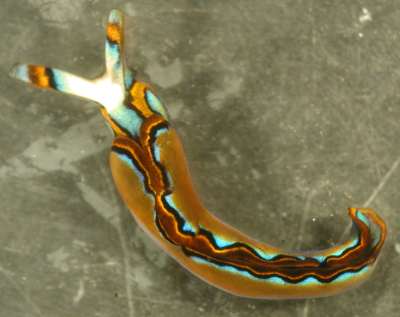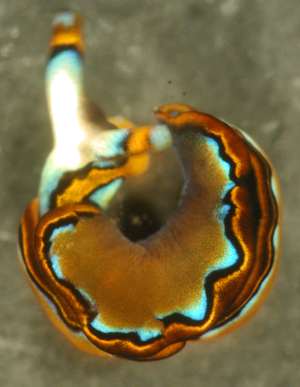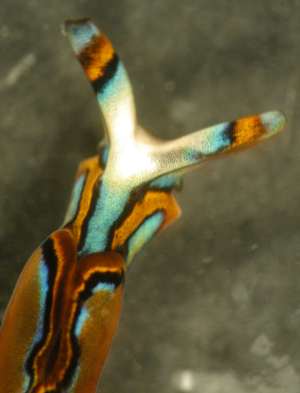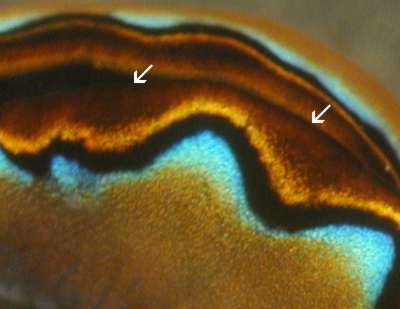Thuridilla neona from Lizard Island
October 31, 2005
From: Ingo Burghardt

Dear Bill,
To join the conversation on Thuridilla [#15121], here are some fotos of one specimen of Thuridilla neona, that I found last year close to Lizard Island. The colour pattern appears quite "classical" for this species. Like Thuridilla livida from the same locality it showed no photosynthetic activity, so probably it does not retain any chloroplasts.
Locality: Bird Island, Lizard Island Group. Great Barrier Reef, Australia. Depth: 1-2 m.. Length: 9 mm. August 2004. Intertidal between coral rubble. Photographer: Ingo Burghardt
Cheers,
Ingo
ingo.burghardt@rub.de



Dear Ingo,
Thanks for these photos which certainly resolved one aspect of the colour pattern for me. I had thought from Cory Pittman's photos [#9719] that in T. neona, the thin bright yellow line was at the edge of the parapodia, and the undulations Terry Gosliner described were referring to the 'wavy' edge of the parapodia. However from your photos - see arrows alongside - there is an orange - or dark brown-orange border which varies in width. This is also the case in Julie Marshall's photos [#15121 ].
Looking back at Cory's photos, I can see that if I interpret the the dark patches along the parapodial edge as the wider parts of a brown-orange border, we have the same pattern as the Great Barrier Reef animals. I had previously interpreted these dark patches as the space inside the parapodia. Now I see the error of my ways it all seesm so clear!
Which brings us to Daniel Foote's animal [#15079]. My feeling now is that it is a well-fed Thuridilla neona. Your observation that this species doen't seem to retain chloroplasts would fit. His animal with green parapodia can be interpreted as a recently fed animal, while the others with orange-brown parapodia would represent 'starving' animals without chloroplasts in their digestive gland ducts. At this stage, I think it is best to interpret the different colour pattern on the head in Daniel's animal, to be part of the species colour variation. Certainly the photos we now have suggest the blue colour along the parapodial edge can range from a line to a series of blue patches.
So after a few days of confusion - mainly on my part - we can pretty safely say that T. neona is no longer just an Hawaiian endemic.
Best wishes,
Bill Rudman
Related messages
-
Thuridilla neona from sthn Queensland
From: Gary Cobb, February 6, 2009 -
Re: Elysia colors
From: Skip Pierce, November 2, 2005 -
Thuridilla neona and colour patterns
From: Skip Pierce, October 31, 2005 -
Re: Thuridilla cf. neona? from Great Barrier Reef
From: Julie Marshall, October 28, 2005 -
Thuridilla cf. neona? from Great Barrier Reef
From: Daniel Foote, October 26, 2005 -
Thuridilla neona? off Townsville, QLD
From: Daniel J. Foote, October 8, 2005 -
Egg masses of Thuridilla neona (1)
From: Cory Pittman, April 23, 2003 -
Egg masses of Thuridilla neona (2)
From: Cory Pittman, April 23, 2003
